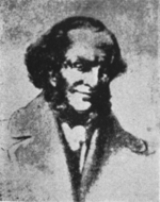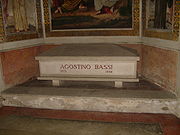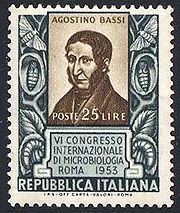
Agostino Bassi
Encyclopedia



Lombardy
Lombardy is one of the 20 regions of Italy. The capital is Milan. One-sixth of Italy's population lives in Lombardy and about one fifth of Italy's GDP is produced in this region, making it the most populous and richest region in the country and one of the richest in the whole of Europe...
– 8 February 1856, in Lodi) was an Italian
Italy
Italy , officially the Italian Republic languages]] under the European Charter for Regional or Minority Languages. In each of these, Italy's official name is as follows:;;;;;;;;), is a unitary parliamentary republic in South-Central Europe. To the north it borders France, Switzerland, Austria and...
entomologist. He preceded Louis Pasteur
Louis Pasteur
Louis Pasteur was a French chemist and microbiologist born in Dole. He is remembered for his remarkable breakthroughs in the causes and preventions of diseases. His discoveries reduced mortality from puerperal fever, and he created the first vaccine for rabies and anthrax. His experiments...
in the discovery that microorganisms can be the cause of disease (the germ theory of disease
Germ theory of disease
The germ theory of disease, also called the pathogenic theory of medicine, is a theory that proposes that microorganisms are the cause of many diseases...
). He discovered that the muscardine disease of silkworms was caused by a living, very small, parasitic organism, a fungus
Fungus
A fungus is a member of a large group of eukaryotic organisms that includes microorganisms such as yeasts and molds , as well as the more familiar mushrooms. These organisms are classified as a kingdom, Fungi, which is separate from plants, animals, and bacteria...
that would be named eventually Beauveria bassiana
Beauveria bassiana
Beauveria bassiana is a fungus that grows naturally in soils throughout the world and acts as a parasite on various arthropod species, causing white muscardine disease; it thus belongs to the entomopathogenic fungi. It is being used as a biological insecticide to control a number of pests such as...
in his honor. In 1844, he stated the idea that not only animal (insect), but also human diseases are caused by other living microorganisms; for example, measles
Measles
Measles, also known as rubeola or morbilli, is an infection of the respiratory system caused by a virus, specifically a paramyxovirus of the genus Morbillivirus. Morbilliviruses, like other paramyxoviruses, are enveloped, single-stranded, negative-sense RNA viruses...
, syphilis
Syphilis
Syphilis is a sexually transmitted infection caused by the spirochete bacterium Treponema pallidum subspecies pallidum. The primary route of transmission is through sexual contact; however, it may also be transmitted from mother to fetus during pregnancy or at birth, resulting in congenital syphilis...
, and the plague
Bubonic plague
Plague is a deadly infectious disease that is caused by the enterobacteria Yersinia pestis, named after the French-Swiss bacteriologist Alexandre Yersin. Primarily carried by rodents and spread to humans via fleas, the disease is notorious throughout history, due to the unrivaled scale of death...
.
He was the son of a wealthy farmer and a lawyer who also had a passion for biology. However, his father did not want him to take up biology, but wanted him instead to look after the family's property, to become a civil servant and to join the Imperial administration.
Bassi did so, but also followed the lessons of Lazzaro Spallanzani
Lazzaro Spallanzani
Lazzaro Spallanzani was an Italian Catholic priest, biologist and physiologist who made important contributions to the experimental study of bodily functions, animal reproduction, and essentially discovered echolocation...
, a relative, until he died.
His studies of 1807 concerned mal de segno (also known as muscardine, after a French candy), a lethal disease of domestic silkworms (Bombyx mori). Infected caterpillars are covered with a fine white powder and die. This disease initially appeared in Italy around 1805; then in France, by 1841. After 1849, the silk
Silk
Silk is a natural protein fiber, some forms of which can be woven into textiles. The best-known type of silk is obtained from the cocoons of the larvae of the mulberry silkworm Bombyx mori reared in captivity...
farms were almost all abandoned because of this devastating disease. The research to find the cause of this disease took him 25 years. Bassi published the results of his investigations in a paper entitled Del mal del segno, calcinaccio o moscardino (1835), stating that a living entity was the culprit, and that it was contagious; we now know that the powdery appearance on the killed silkworms is caused by the production of millions of infectious white fungal spores on the dead insect (see Beauveria bassiana
Beauveria bassiana
Beauveria bassiana is a fungus that grows naturally in soils throughout the world and acts as a parasite on various arthropod species, causing white muscardine disease; it thus belongs to the entomopathogenic fungi. It is being used as a biological insecticide to control a number of pests such as...
). He is credited with rescuing the economically important silk
Silk
Silk is a natural protein fiber, some forms of which can be woven into textiles. The best-known type of silk is obtained from the cocoons of the larvae of the mulberry silkworm Bombyx mori reared in captivity...
industry, by recommendations like the use of disinfectants; separating the rows of feeding caterpillars; isolating and destroying infected caterpillars; and keeping the farms clean. This brought Bassi immediate fame. "Del Mal del Segno, Calcinaccio o Moscardino" was translated into French and distributed throughout Europe.
From this work he expanded on a theory explaining that many disease
Disease
A disease is an abnormal condition affecting the body of an organism. It is often construed to be a medical condition associated with specific symptoms and signs. It may be caused by external factors, such as infectious disease, or it may be caused by internal dysfunctions, such as autoimmune...
s of plants, animals and human beings were caused by pathogenic organisms. He thus preceded the work of Louis Pasteur
Louis Pasteur
Louis Pasteur was a French chemist and microbiologist born in Dole. He is remembered for his remarkable breakthroughs in the causes and preventions of diseases. His discoveries reduced mortality from puerperal fever, and he created the first vaccine for rabies and anthrax. His experiments...
and Robert Koch
Robert Koch
Heinrich Hermann Robert Koch was a German physician. He became famous for isolating Bacillus anthracis , the Tuberculosis bacillus and the Vibrio cholerae and for his development of Koch's postulates....
. He was also the author of work on the culture of potatoes, on cheese, wine making, leprosy
Leprosy
Leprosy or Hansen's disease is a chronic disease caused by the bacteria Mycobacterium leprae and Mycobacterium lepromatosis. Named after physician Gerhard Armauer Hansen, leprosy is primarily a granulomatous disease of the peripheral nerves and mucosa of the upper respiratory tract; skin lesions...
and cholera
Cholera
Cholera is an infection of the small intestine that is caused by the bacterium Vibrio cholerae. The main symptoms are profuse watery diarrhea and vomiting. Transmission occurs primarily by drinking or eating water or food that has been contaminated by the diarrhea of an infected person or the feces...
.
Louis Pasteur (1822–1895) was greatly influenced by his work. Pasteur had the portraits of both Spallanzani and Bassi in his office.
Bassi’s tomb in Lodi
Agostino Bassi was buried in the beautiful RomanesqueRomanesque architecture
Romanesque architecture is an architectural style of Medieval Europe characterised by semi-circular arches. There is no consensus for the beginning date of the Romanesque architecture, with proposals ranging from the 6th to the 10th century. It developed in the 12th century into the Gothic style,...
church of Saint Francis
San Francesco, Lodi
San Francesco is a church in Lodi, Lombardy, northern Italy, dating to the late 13th century. Its main peculiarity are the two "open sky" double mullioned windows in the façade, which are the first example of a model often repeated in northern Italy in the 14th and 15th centuries.-History:The...
(13th century). His tomb can be seen in the right transept
Transept
For the periodical go to The Transept.A transept is a transverse section, of any building, which lies across the main body of the building. In Christian churches, a transept is an area set crosswise to the nave in a cruciform building in Romanesque and Gothic Christian church architecture...
, laid to a wall, at the ground level.
Philately
In 1953 the Italian post office issued a stampPhilately
Philately is the study of stamps and postal history and other related items. Philately involves more than just stamp collecting, which does not necessarily involve the study of stamps. It is possible to be a philatelist without owning any stamps...
on the 180th anniversary of Bassi's birth in 1773. The stamp features a portrait of Bassi bordered by silkmoth adults and pupae http://www.bugsonstamps.com/italy/italy_01_moth.htm.

